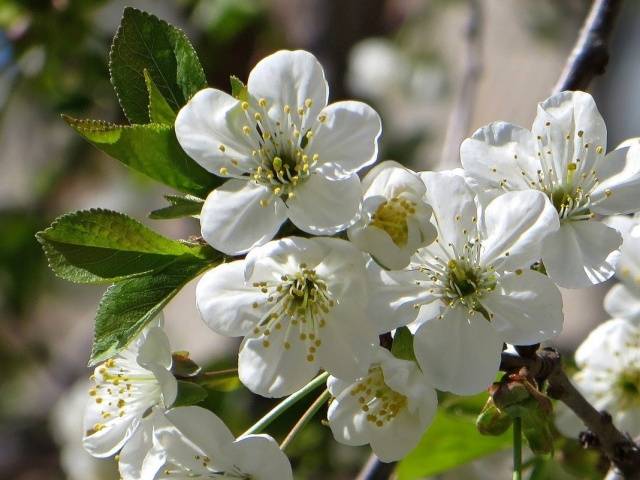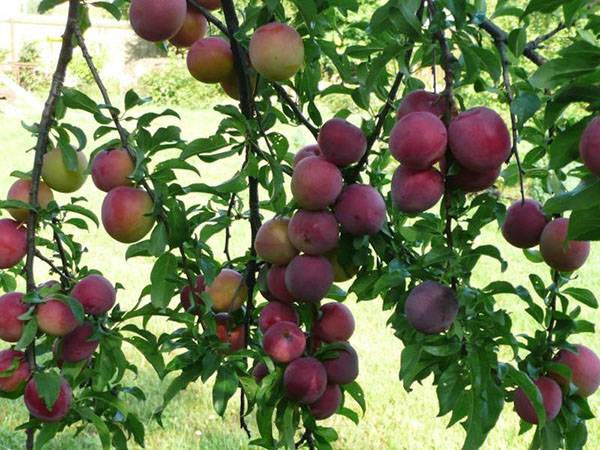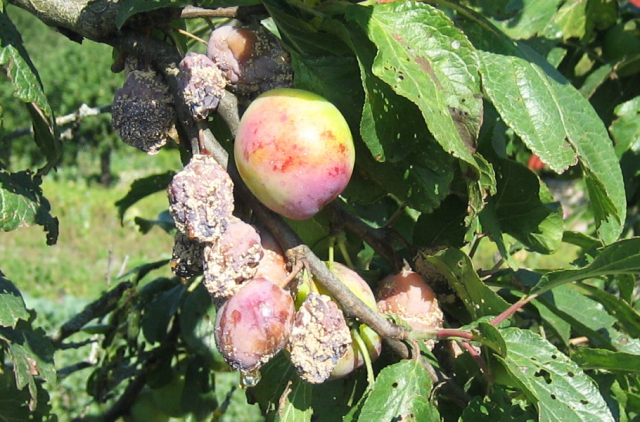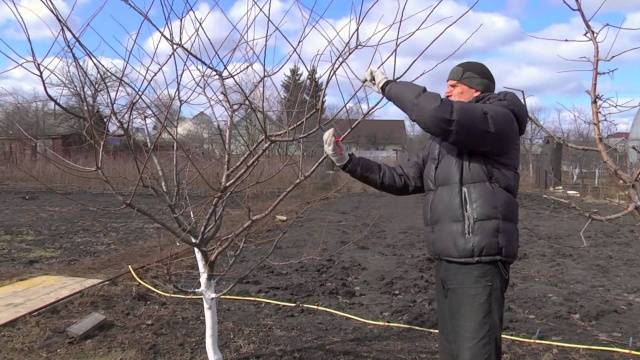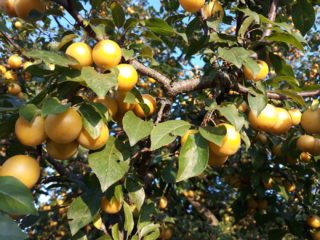Content
- 1 Breeding history
- 2 Description of culture
- 3 Characteristics
- 3.1 Drought resistance and winter hardiness
- 3.2 Pollination, flowering period and ripening times
- 3.3 Productivity and fruiting
- 3.4 Scope of the fruit
- 3.5 Disease and pest resistance
- 3.6 Advantages and disadvantages
- 3.7 Landing features
- 3.8 Recommended timing
- 3.9 Choosing the right place
- 3.10 What crops can and cannot be planted next to cherry plum
- 3.11 Selection and preparation of planting material
- 3.12 Landing algorithm
- 4 Follow-up care of the culture
- 5 Diseases and pests
- 6 Conclusion
- 7 Testimonials
Cherry plum Traveler is an unpretentious variety with a short ripening period. The hybrid is valued for its high yield of juicy fruits and resistance to most fungal diseases. Subject to agrotechnical measures, it gives a stable harvest of cherry plum annually.
Breeding history
The variety of plum (cherry-plum) Traveler was bred by the scientists G.V. Eremin and L. Ye. Velenchuk, employees of the Crimean Experimental Breeding Station of the All-Russian Research Institute of Plant Industry of N. I. Vavilov, in 1977. It was obtained by crossing the Tavricheskaya cherry plum and the Chinese Burbank plum. Designed for cultivation in the Central, North Caucasian, Central Black Earth and Northwest regions. Since 1986, the variety has been included in the State Register of Breeding Achievements.
Description of culture
The fruit tree has a rounded crown and reaches a height of 3-3.5 m. The trunk is medium branched, with a smooth light gray bark and many lentils. The leaves of this cherry plum have an oval shape with a pointed tip, a shiny surface with slight pubescence. From each bud, 2 white flowers are formed with a pronounced aroma that attracts insects. In the photo of the cherry plum Traveler during flowering, it can be seen that the petals are large, a long pistil surrounded by many yellow stamens.
According to biological description of cherry plum Traveler fruits in the stage of technical maturity have a mass of 19-28 grams. The plum's reddish-purple skin is smooth, with a slight waxy coating. The pulp is characterized by orange color, slight acidity and sugar content. The Traveler plum stone is of medium size and weight.
Characteristics
The Traveler Russian plum hybrid is grown in many regions due to its ability to produce an early harvest even in frosty winters. Cultivation of the variety does not require significant efforts from gardeners. Plum Traveler is rarely affected by fungal diseases, while it is sensitive to moisture levels and spring frosts.
Drought resistance and winter hardiness
One of the characteristics of the Traveler cherry plum variety is good resistance to low temperatures in winter. The fruit tree can withstand up to -30 ° C, which corresponds to climatic zone 4. The danger is posed by recurrent frosts during the formation of plum buds. A sharp drop in temperature leads to the fall of flowers.
A hybrid of plum and cherry plum is characterized by moderate drought tolerance. The culture reacts equally badly to high soil moisture and lack of water, especially in hot weather. Insufficient watering provokes partial shedding of leaves and ovaries. Stagnant water leads to root rot.
Pollination, flowering period and ripening times
Abundant plum blossom The traveler in central Russia begins in the 3rd decade of April. Low spring temperatures can delay bud appearance by 1 to 2 weeks. The Russian plum tree is self-fertile. It is recommended to plant plums and cherry plums of other varieties, for example, Skoroplodnaya or Chinese, as pollinators for the Traveler cherry plum.The ripening period is 2-2.5 months from the date of ovary formation. The crop can be harvested in early July.
Productivity and fruiting
Reviews of the plum (cherry plum) Traveler from gardeners indicate high yields over the years. From one tree older than 4-5 years old, you can collect 35-40 kg of fruits. This indicator is achieved due to the large number of ovaries with relatively small fruit sizes.
During the period of mass ripening of fruits, it is necessary to harvest the crop in a timely manner, without waiting for its shedding. The Traveler variety has a low keeping quality. A cherry plum that has fallen from a branch quickly deteriorates and rots.
Scope of the fruit
Juicy, sweet flesh of the Traveler plum with a pleasant sour taste is used for various types of preservation and consumption of fresh fruits. Jam and juice with pulp received a high tasting rating. Plum is perfect for freezing and preparing compotes.
Disease and pest resistance
Like most hybrids, the Traveler is immune to major diseases that affect fruit trees. Unfavorable weather conditions in the form of prolonged rains at high air temperatures can lead to the appearance of fungal diseases.
Gardeners note the resistance of the variety to pests, while observing preventive measures of protection against harmful insects.
Advantages and disadvantages
The Plum Hybrid Traveler, developed by breeders, combines several of the best characteristics of crossed varieties:
- short ripening period;
- resistance to low temperatures;
- high productivity;
- immunity to moniliosis and clotterosporia.
In the reviews about the cherry plum Traveler, the unpretentiousness of the fruit tree and a stable harvest of sweet fruits with a pronounced fruity aroma are noted. Among the disadvantages of the variety stands out:
- small fruit size with hard-to-peel pits;
- short storage period of the crop and the impossibility of transportation;
- low resistance to long dry periods.
Landing features
The cherry plum variety Traveler takes root on the site and is distinguished by its yield, subject to conditions, planting technology and proper care. Before placing in the garden with a fruit tree, you should consider the requirements of the culture.
Recommended timing
Regardless of the region in which the Traveler hybrid will be grown, the optimal time for planting a young tree is in the spring months. It is recommended to plant cherry plum before the buds bloom. In this case, the seedling will successfully root during the season and withstand the winter well. In the southern regions, it is allowed to plant plums in the fall after leaf fall. Before the onset of frost, there should be 2-2.5 months left for the tree to adapt the root system.
Choosing the right place
A large number of fruits and their taste directly depend on the area where the cherry plum Russian Traveler grows. This type of plum needs a lot of sunlight. In the shade of large trees or houses on cherry plum, fewer fruits are tied. A heat-loving culture develops better in areas protected from through winds. It is recommended to plant Russian plums near small buildings and fences.
What crops can and cannot be planted next to cherry plum
The red-fruited plum The Traveler feels well in the garden next to stone fruit trees. Experts recommend combining different varieties of the same species on the site, acting as pollinators for each other. Do not plant Solanaceae, large shrubs or tall trees near a tree.
Selection and preparation of planting material
In nurseries, one-year-old or two-year-old seedlings of the Traveler cherry plum, grown from cuttings or with the help of root shoots, should be preferred. In comparison with grafted trees, they are distinguished by better survival rate and cold resistance.
Plum seedlings should have smooth erect shoots and a developed root system. It is necessary to make sure that there are no mechanical damage and signs of disease on the trees. Before planting seedlings with an open root system, the plant should be treated with a growth stimulant.
Landing algorithm
A pit for planting a tree is prepared in 2-3 weeks. The recommended hole depth is 70 cm, diameter - 100 cm.The landing algorithm involves several successive stages:
- The soil is mixed with rotted compost and a glass of wood ash.
- A fertile layer is poured into the bottom of the hole with a slide.
- At a distance of 20 cm from the center of the pit, a high peg is driven in for support.
- The roots of the seedling are spread on the surface of the mound.
- Carefully fill the hole with the remaining earth.
- Tie the plant to a peg and spill the earth around the tree.
Follow-up care of the culture
Planting and caring for the Traveler cherry plum has no significant differences from other varieties. Russian plum most of the time does not require attention and effort from the gardener. Agricultural technology consists in watering, soil mulching and disease prevention. Particular attention should be paid to the formation of the crown.
A year after planting, it is necessary to shorten the shoots by 1/3 of the length and disinfect the cut sites. In the future, the formation of the crown is carried out annually in the autumn months. The branches growing inward, diseased and damaged shoots should be cut off, as well as shortened strongly overgrown over the season.
Watering the Traveler plum is important in the first weeks after planting the seedling and in dry weather. The rest of the time the tree has enough natural precipitation. To maintain moisture, it is advisable to provide the soil with a mulch layer. The introduction of ammonium nitrate and potassium salt during the period of ovary formation has a beneficial effect on the yield.
Diseases and pests
One of the advantages of the Traveler cherry plum variety is resistance to fungal diseases and harmful insects. In most cases, it is sufficient to carry out preventive spraying of shoots and whitewashing of the plum trunk in a timely manner. For processing, a solution of copper sulfate or 1% Bordeaux liquid is used. If the spread of aphids and yellow sawfly is observed on the site, the trees should be sprayed with an insecticide. To protect against rodents, it is recommended to tie the tree trunk with spruce branches.
Conclusion
Cherry plum Traveler is grown in most regions due to the frost resistance of the culture. The popularity of the variety is explained by the high yield of early fruits with low labor costs. Gardeners are attracted by the opportunity to get vitamin fruits at the beginning of July. Useful information about the features of growing cherry plum Traveler in the video
Testimonials
Gardeners share their reviews about cherry plum Traveler in the Moscow region.
